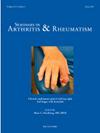The prognostic importance of worsening dyspnoea in systemic sclerosis related interstitial lung disease
IF 4.4
2区 医学
Q1 RHEUMATOLOGY
引用次数: 0
Abstract
Objectives
To determine the prognostic importance of worsening dyspnoea in systemic sclerosis (SSc) related interstitial lung disease (ILD).
Methods
SSc patients were recruited from the Australian Scleroderma Cohort Study. ILD was defined as present if characteristic fibrotic changes on high-resolution computer tomography (HRCT) scan lung were seen, performed based on clinical suspicion. Determinants of survival in SSc-ILD were analysed, specifically the prognostic impact of ILD progression, defined according to the ATS, INBUILD and spirometric definitions of progressive pulmonary fibrosis, and the presence of worsening dyspnoea using accelerated failure time survival analysis.
Results
In our cohort of 2198 SSc patients, 17.7% (n = 389) developed incident ILD over a median (IQR) follow-up period of 5.8 (2.8–9.9) years. A third of our incident ILD cohort (38.3%, n = 149) experienced progressive ILD. In those who experienced progressive ILD, mortality was significantly higher in those who reported recent worsening dyspnoea in the prior month irrespective of a decline in spirometric parameters.
Conclusion
38.8% of those with incident ILD experienced ILD progression over follow-up. Patient-reported worsening dyspnoea in the month prior, irrespective of changes in spirometry, was strongly associated with mortality, with a magnitude equivalent to that of the presence of progressive ILD as defined by the ATS, INBUILD and spirometric definitions of progressive ILD. This study has highlighted the prognostic importance of patient-reported symptoms in the evaluation of SSc-ILD.
系统性硬化症相关间质性肺病患者呼吸困难加重的预后重要性
目的:探讨呼吸困难加重对系统性硬化症(SSc)相关间质性肺疾病(ILD)预后的影响。方法:从澳大利亚硬皮病队列研究中招募SSc患者。如果基于临床怀疑在高分辨率计算机断层扫描(HRCT)上看到特征性纤维化改变,ILD被定义为存在。分析SSc-ILD的生存决定因素,特别是ILD进展的预后影响,根据ATS, INBUILD和进行性肺纤维化的肺活量测定定义,以及使用加速失败时间生存分析的呼吸困难恶化的存在。结果:在我们的2198例SSc患者队列中,17.7% (n = 389)在中位(IQR)随访期间(5.8(2.8-9.9)年)发生了ILD。我们的突发ILD队列中有三分之一(38.3%,n = 149)经历了进行性ILD。在那些经历进行性ILD的患者中,那些在前一个月报告最近呼吸困难恶化的患者的死亡率明显更高,而与肺活量测定参数的下降无关。结论:38.8%的ILD患者在随访期间出现ILD进展。患者报告的前一个月呼吸困难加重,与死亡率密切相关,其程度与ATS、INBUILD和肺活量法定义的进行性ILD存在的程度相当。这项研究强调了在评估SSc-ILD时患者报告的症状对预后的重要性。
本文章由计算机程序翻译,如有差异,请以英文原文为准。
求助全文
约1分钟内获得全文
求助全文
来源期刊
CiteScore
9.20
自引率
4.00%
发文量
176
审稿时长
46 days
期刊介绍:
Seminars in Arthritis and Rheumatism provides access to the highest-quality clinical, therapeutic and translational research about arthritis, rheumatology and musculoskeletal disorders that affect the joints and connective tissue. Each bimonthly issue includes articles giving you the latest diagnostic criteria, consensus statements, systematic reviews and meta-analyses as well as clinical and translational research studies. Read this journal for the latest groundbreaking research and to gain insights from scientists and clinicians on the management and treatment of musculoskeletal and autoimmune rheumatologic diseases. The journal is of interest to rheumatologists, orthopedic surgeons, internal medicine physicians, immunologists and specialists in bone and mineral metabolism.

 求助内容:
求助内容: 应助结果提醒方式:
应助结果提醒方式:


